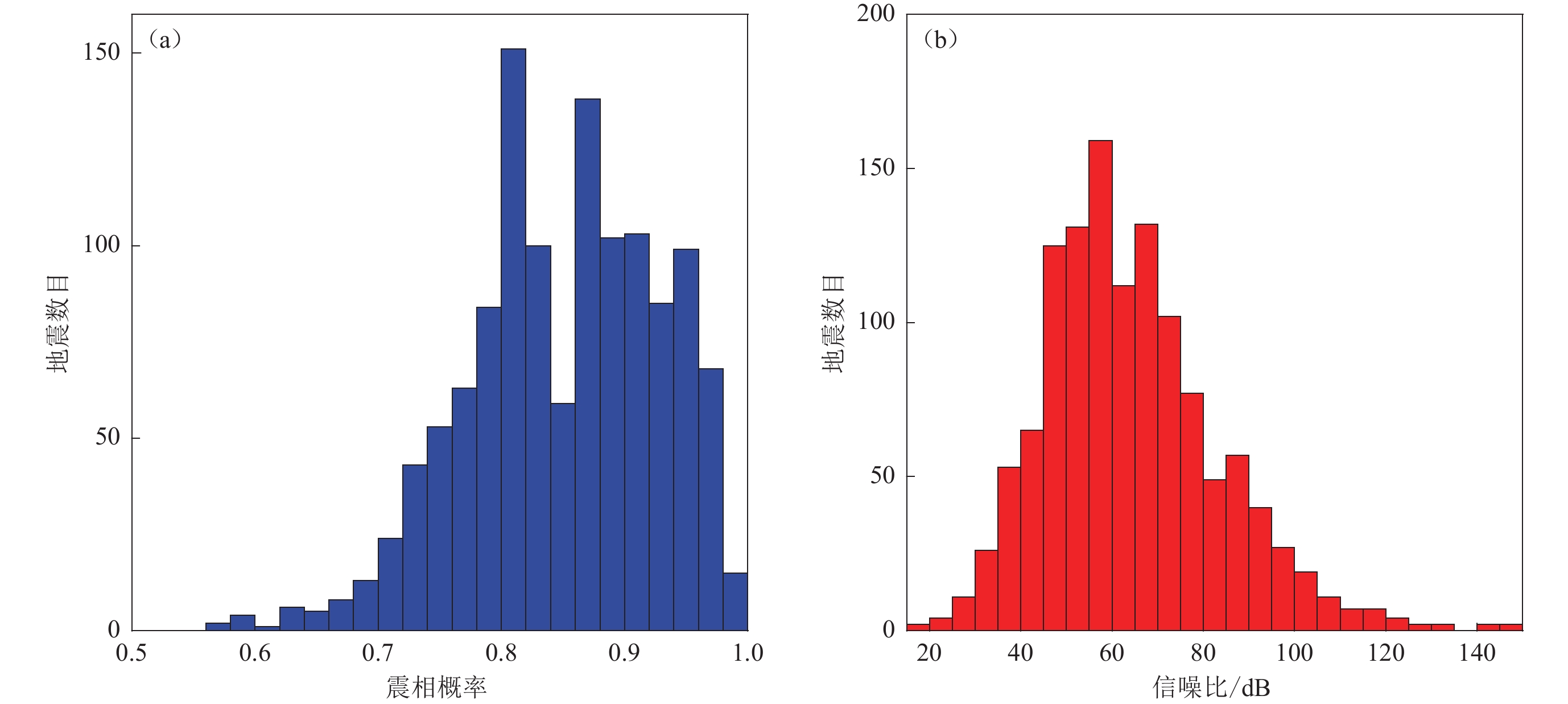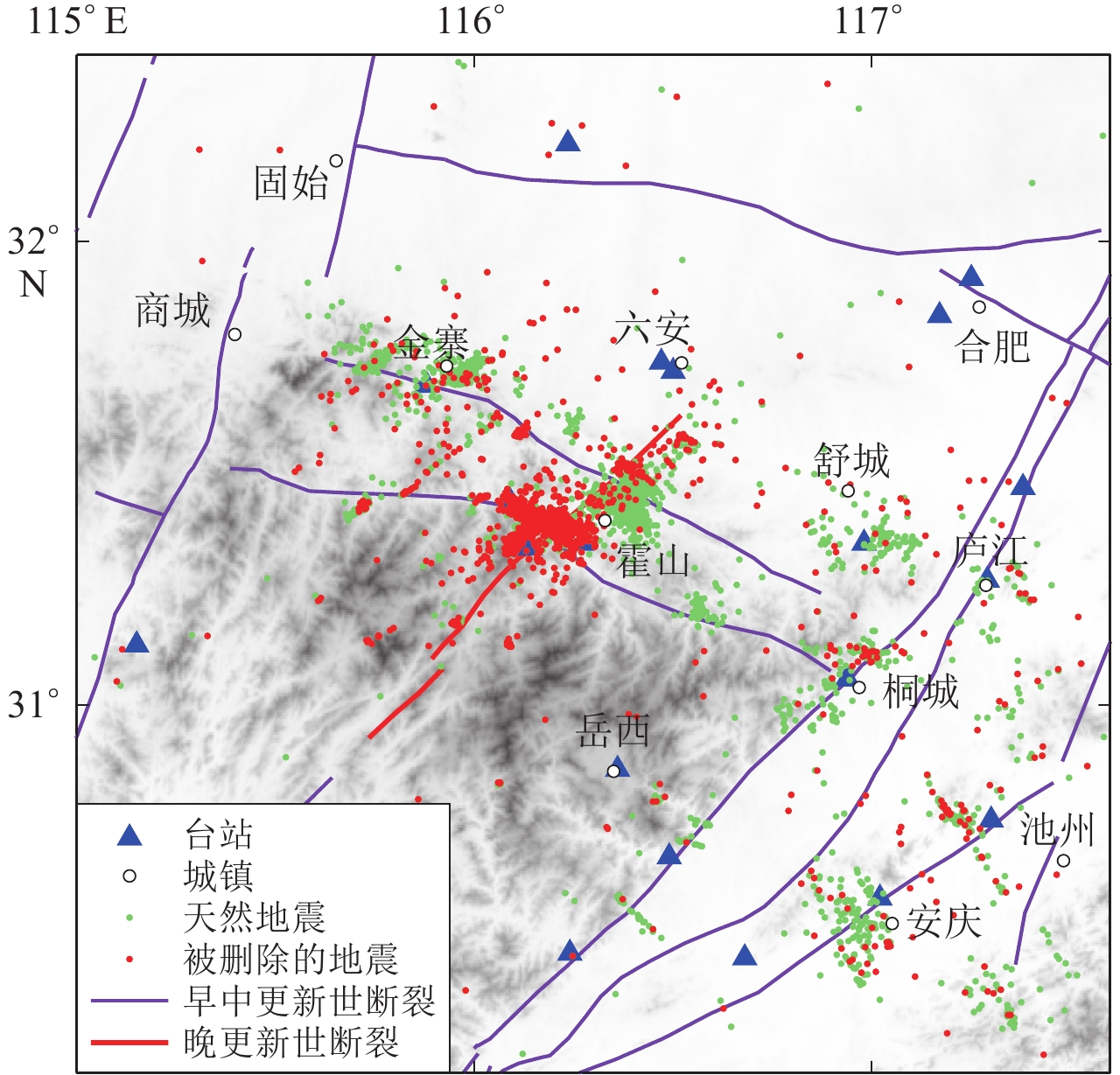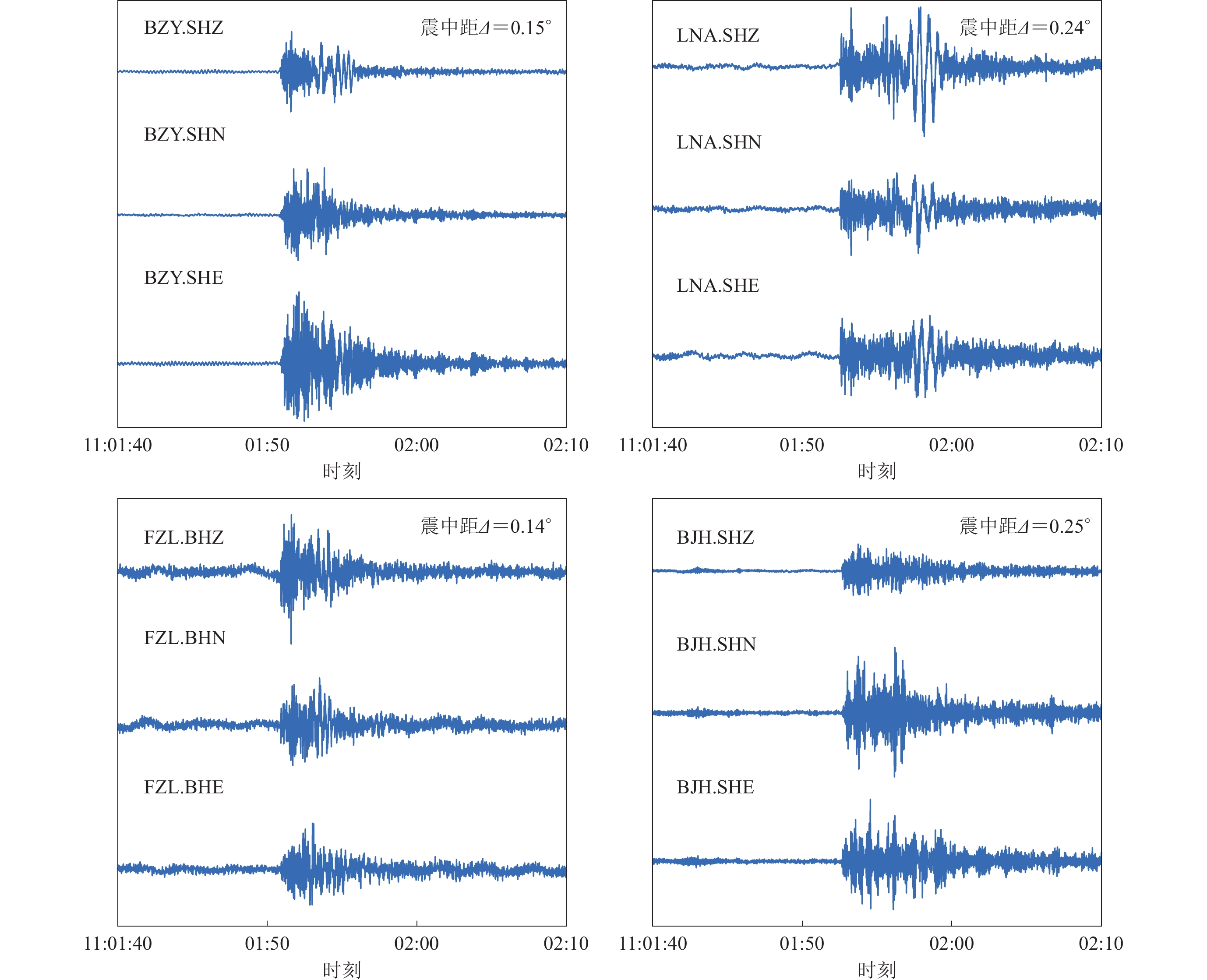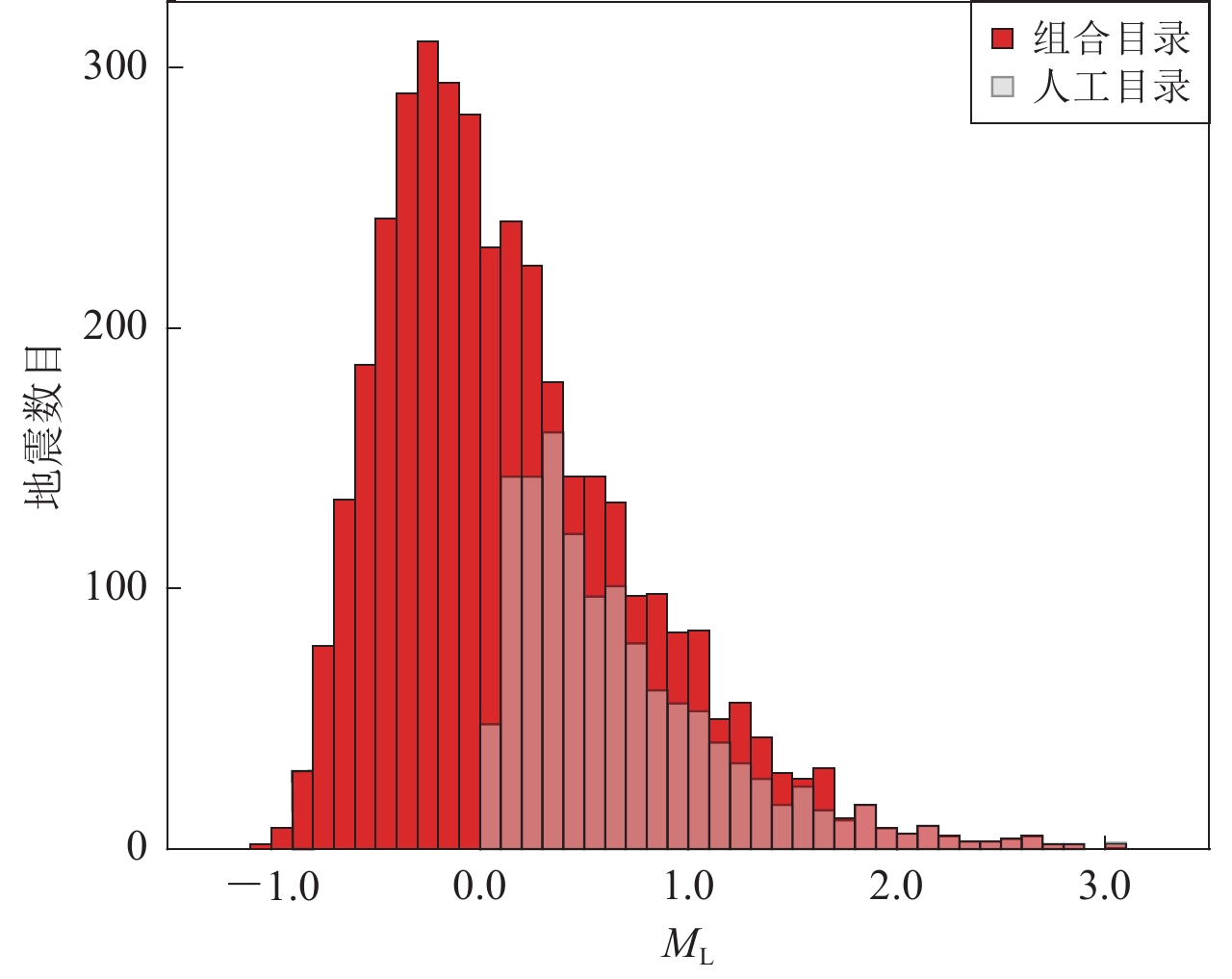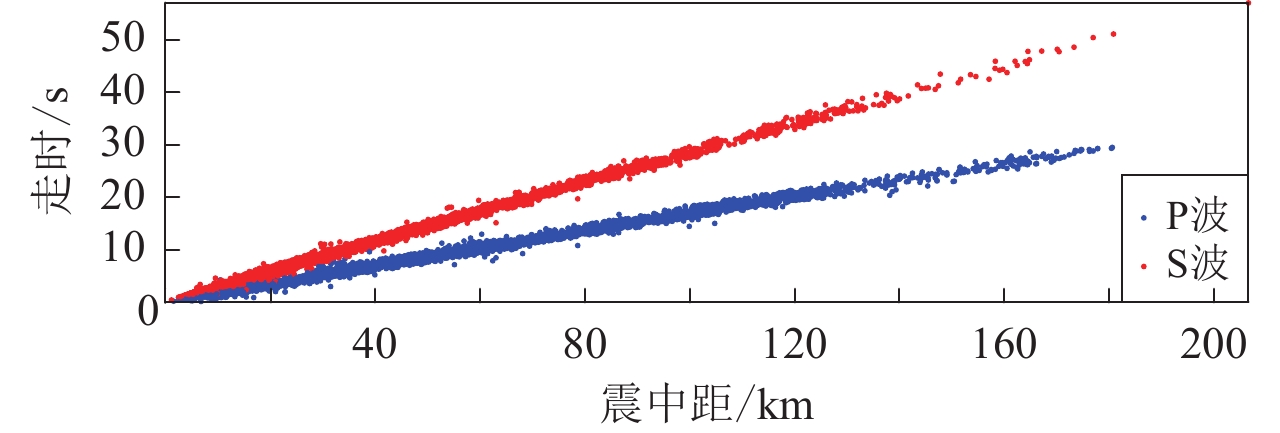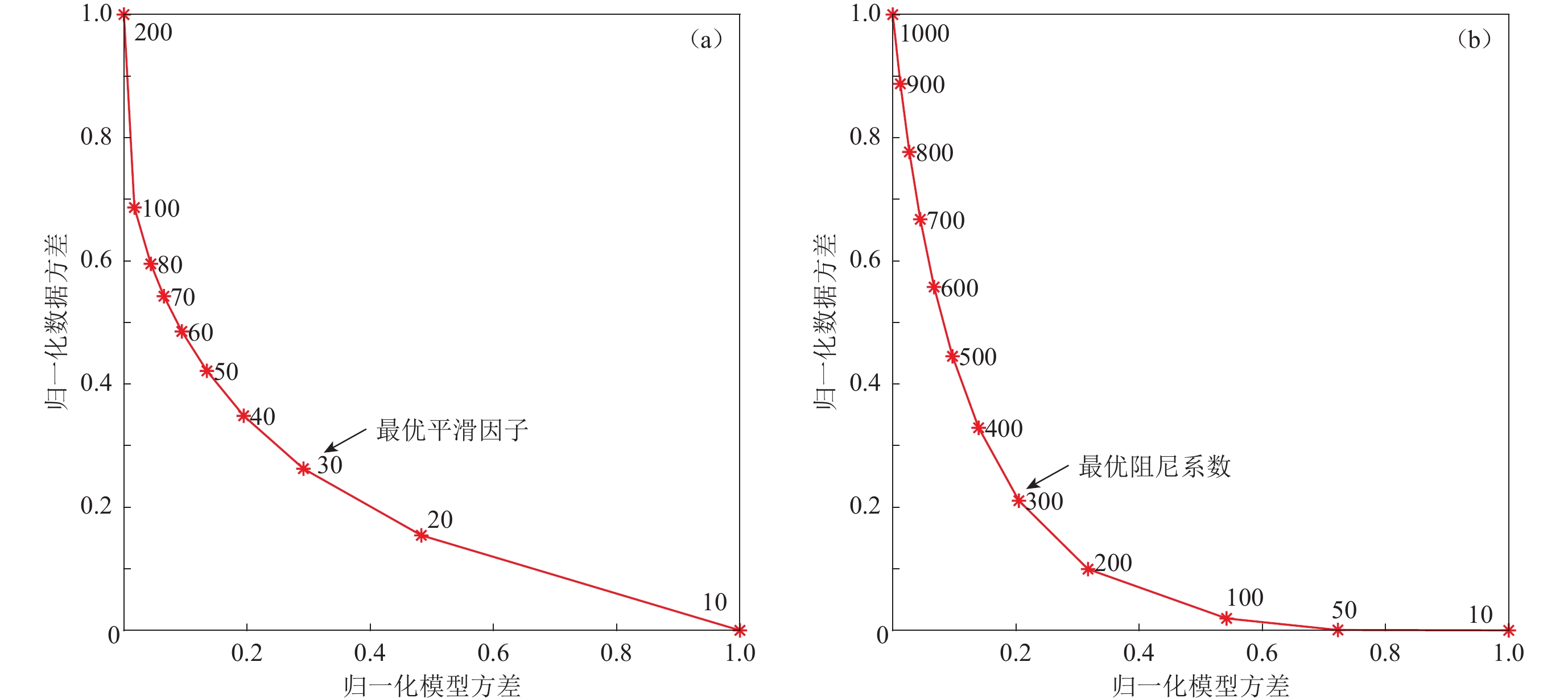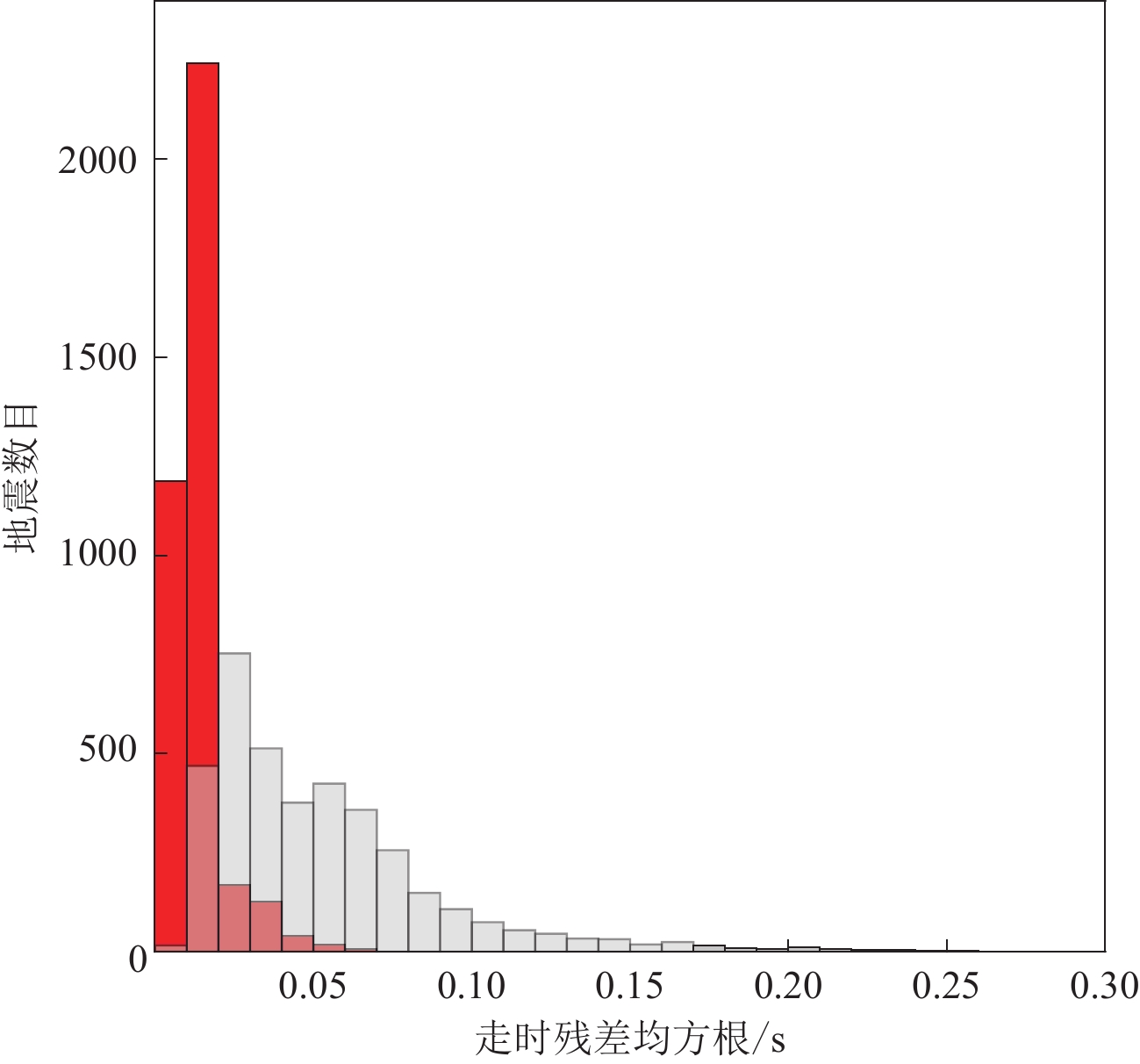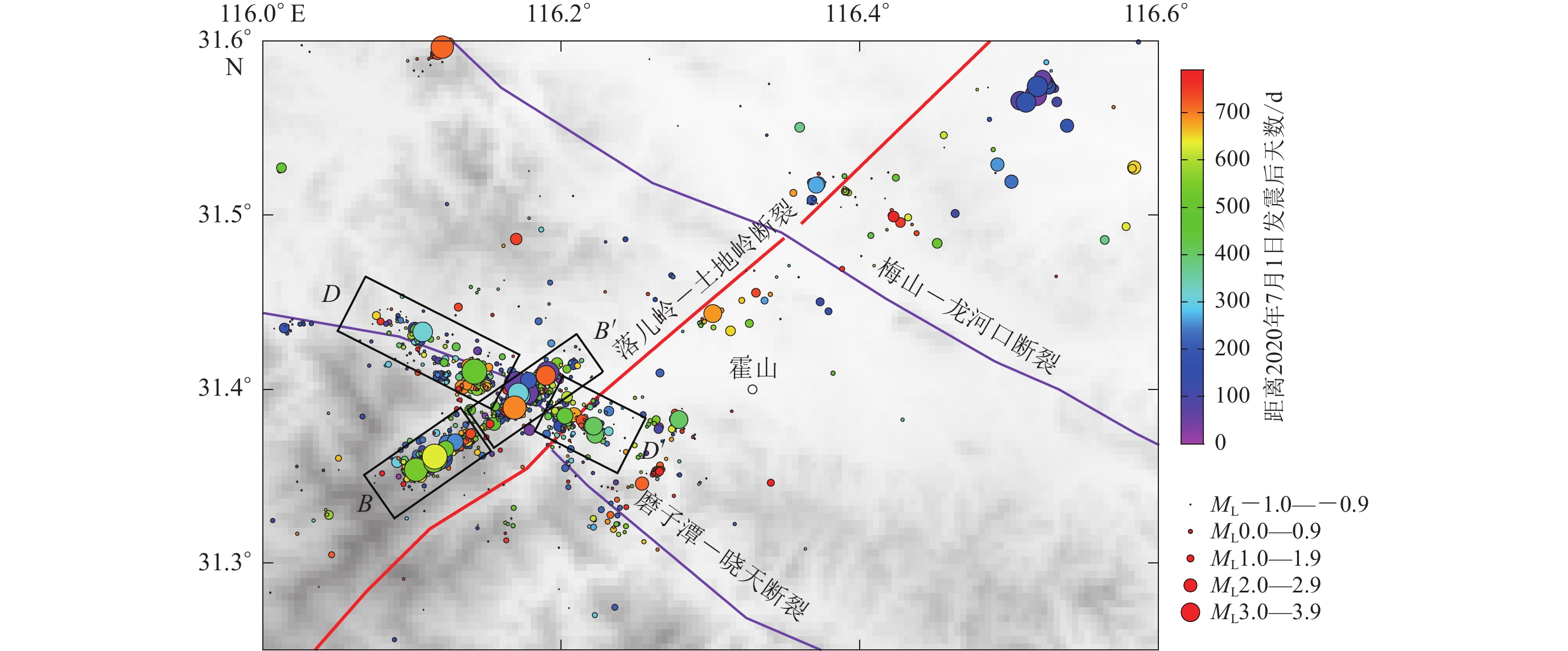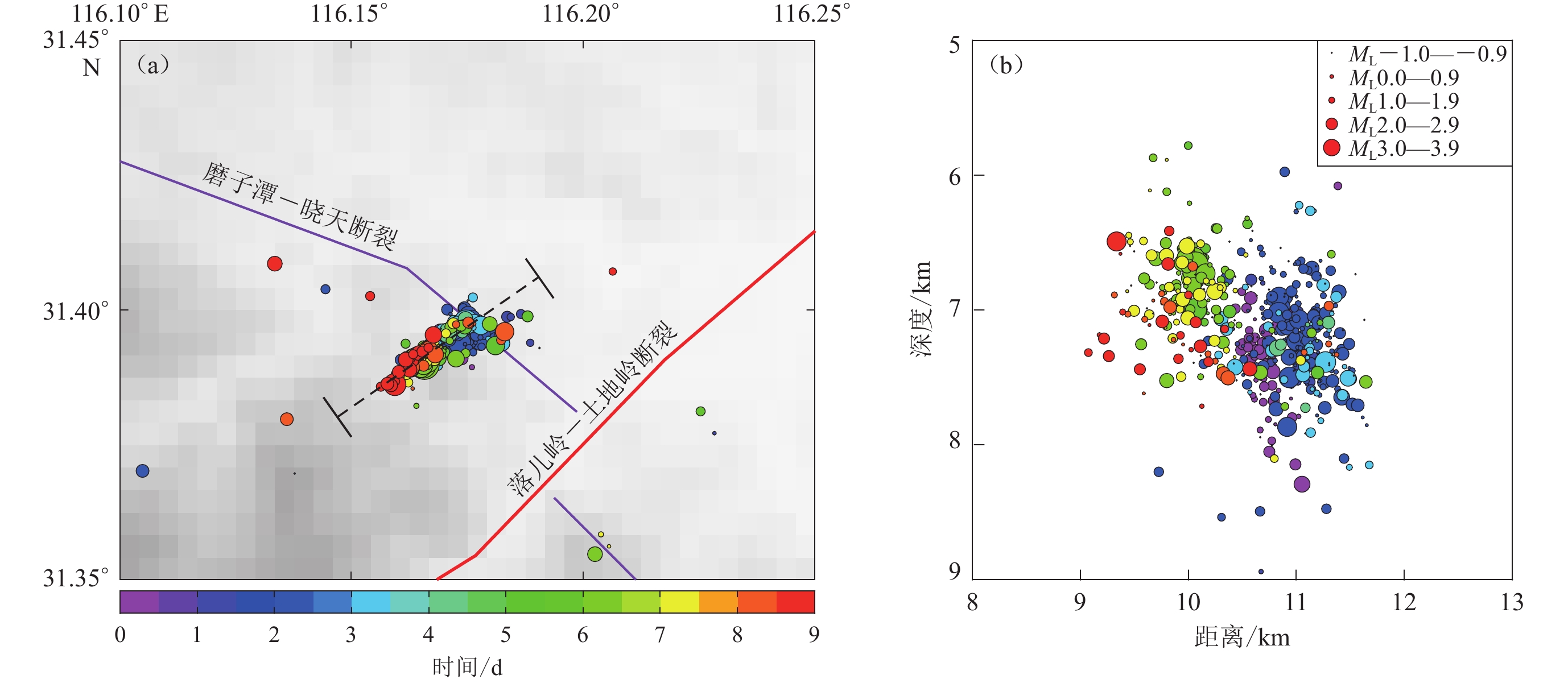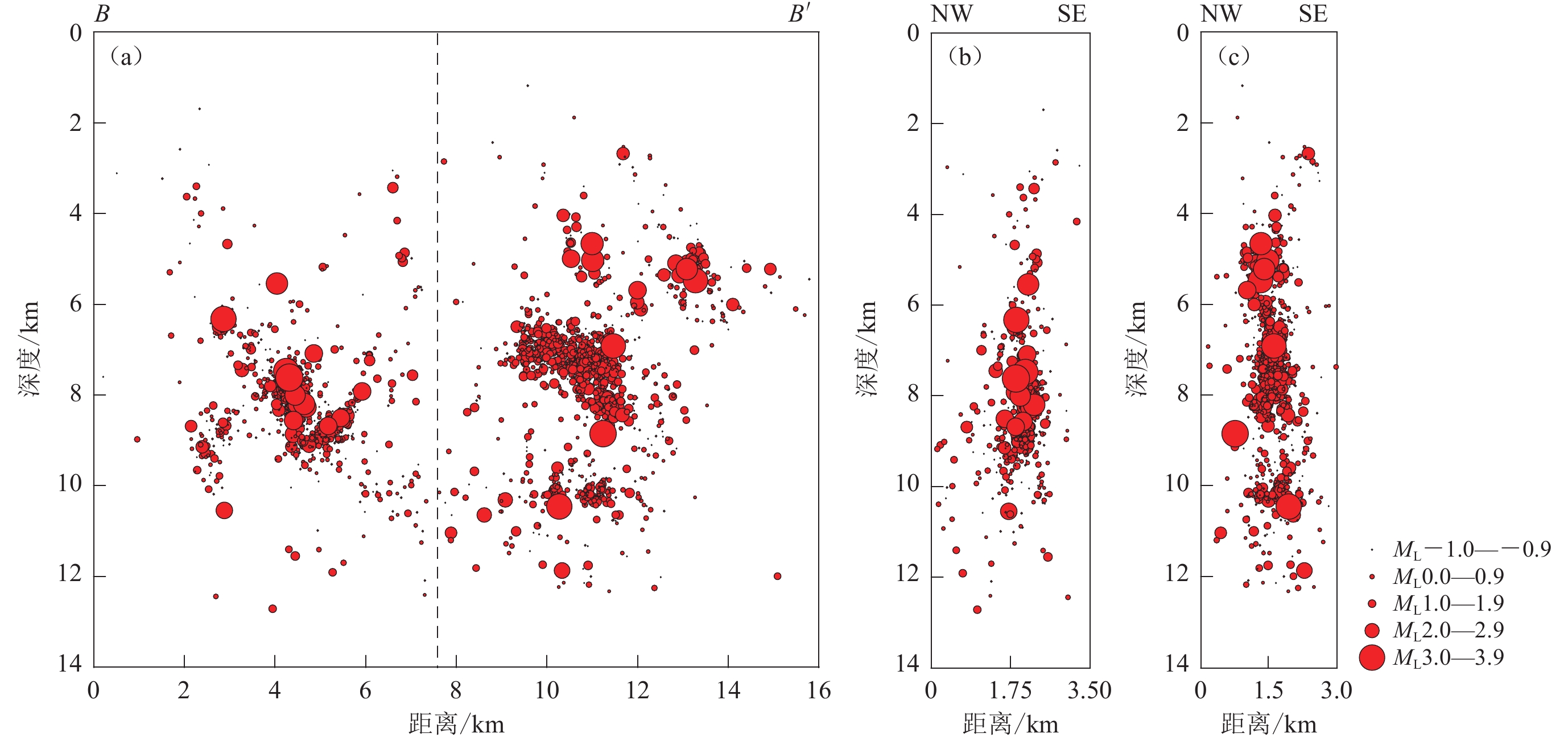Temporal and spatial characteristics of small earthquakes in Huoshan area,Anhui Province
-
摘要:
利用基于人工智能算法PhaseNet的地震处理系统RISP,对安徽省霍山地区2020年7月至2022年8月连续两年的地震波形资料进行了扫描,检测到
3839 个地震事件,这一数量是人工目录的3倍。地震识别匹配率达到了95%。该系统能产出各震级段的地震目录,特别是震级ML−1.1—0.0段的微小地震,提升了该地区地震监测能力ML0.5,解决了人工目录缺乏ML0以下微震的问题。结合当地的地震监测能力,使用人工和RISP自动目录组合的新目录,进行tomoDD重新定位。结果表明,在落儿岭—土地岭断裂与磨子潭—晓天断裂的交会部位出现两个呈分段式丛集分布的地震条带,它们的优势分布方向与断裂的走向一致。北东向的BB′条带规模更大,其倾角近垂直。北西向的DD′条带规模相对较小,其倾角为65°—78°。BB′条带分为西南和东北两个部分,西南侧地震较少且震源较浅。而东北侧地震较多且震源的深度变化区间更大,倾角更陡。在平静期内霍山地区的地震没有明显的规律,但在2021年2月1日至10日密集地发生了641次地震,时间特征明显:地震先从断层面中间开始,然后向东北侧转移,最后转移至西南侧,表现出显著的地震活动迁移特征,可能是受流体控制作用的结果。Abstract:The Huoshan area is located in the eastern part of the Chinese mainland, at the intersection of the Qinling-Dabie orogenic belt and the Tanlu seismic belt. The faults in the area are strongly active and earthquakes occur frequently. The main faults developed are the NE-trending Late Pleistocene active fault Luo’erling-Tudiling fault, the nearly EW-trending Mozitan-Xiaotian fault and Meishan-Longhekou fault. The NE-trending Luo’erling-Tudiling fault is the main earthquake-controlling and seismogenic structure. It cuts across the above-mentioned nearly EW-trending faults and passes through the North Dabie block, the North Huaiyang block and the Hefei basin from south to north. This region has always been a key monitoring area for earthquake prediction in the eastern part of China, often referred to as a “window” for studying stress field variations and seismic activity in the East China region. Acquiring a high-precision micro-seismic catalog for the Huoshan region is of significant importance in delineating fault morphology and seismic prediction.
In this study, the seismic processing system RISP (real-time intelligent seismic processing system) based on the artificial intelligence algorithm PhaseNet was used to scan the continuous waveform data of Huoshan area from 2020 to 2022, ranging from (30.2°N—32.4°N, 115°E—117.6°E). There are 21 seismic stations within 120 km of the Huoshan earthquake swarm. The seismic catalog was screened by parameters such as signal-to-noise ratio and phase (accuracy) probability, and an automatic catalog containing
3839 earthquakes was obtained. The number is three times that of the manual catalog.The RISP uses deep learning method to detect earthquakes, which includes phase picking, association, location and magnitude measurement. The system currently lacks the capability to identify non-natural earthquakes and locate tele-seismic events, leading to cases of non-natural earthquakes and misidentification of distant earthquakes as local events in the earthquake catalog. In addition to screening the catalogs, this study combined manual and automatic catalogs for relocation based on local monitoring capabilities: the manual catalog was used for earthquakes above the monitoring capacity, while the automatic catalog was used for smaller events. The combined catalog contained
3825 earthquakes, 14 fewer than the automatic catalog. The double-difference earthquake location and imaging method tomoDD is a relative location method that significantly improves the accuracy of earthquake location. After relocation using tomoDD,3785 earthquakes were obtained, with 40 earthquakes unable to be located due to not meeting the criteria. The RISP system exhibits a 95% earthquake identification matching rate in the Huoshan region, providing earthquake catalogs of each magnitude range, particularly enhancing the seismic monitoring capabilities for micro-earthquakes in the ML−1.1—0.0, addressing the lack of sub-magnitude 0 earthquakes in the manual catalog.Two seismic belts appear at the intersection of the Luo’erling-Tudiling fault and the Mozitan-Xiaotian fault. Their dominant distribution direction is consistent with the strike of the fault. The NE-trending belt BB′ is parallel to the Luo’erling-Tudiling fault and is distributed on its west side, whose length is about 16 km. The earthquakes are concentrated about 3—3.5 km wide. The focal depth is between 4—12 km. The belts are distributed in two sections, and their shapes are different. The cross-section of the vertical seismic belt shows a slightly gentler dip in the southwest segment compared to the northeast segment, but both are nearly vertical. The Luo’erling-Tudiling fault strikes northeast, with a northwest dip angle ranging from 64° to 84°. Field fault geomorphological evidence indicates that the most recent activity of the fault occurred from the late Middle Pleistocene to the early Late Pleistocene, predominantly characterized by dextral strike-slip extensional faults. The focal mechanism of the M4.3 earthquake that occurred on this fault in 2014 indicates a dextral strike-slip fault. This seismic belt may be its branch fracture, and the two converge together in the deep. The northwest-trending belt DD′ consists of several small clusters, concentrated within 4 km wide along the Mozitan-Xiaotian fault, extending approximately 20 km. The belt indicates the recent activity of the fault in this part. The cross-section of the DD′ belt shows a dip angle of approximately 65° in the northwest segment and around 78° in the southeast segment, both dip northeast.
Regarding the seismogenic structures in the Huoshan region, Cui et al (2020) revealed through deep electromagnetic surveys that the Luo’erling-Tudiling fault serves as the seismogenic structure, utilizing weak zones formed by early activity along the Mozitan-Xiaotian fault, where fluid from the highly conductive layer below the fault weakens the fault, leading to the occurrence of seismic swarms in these zones of weakness. Xu et al (2022) used precise location results to reveal three nearly parallel seismic bands, suggesting a strike-slip and extensional fault system formed under the combined effects of the right-lateral Tanlu fault zone and the south segment of the Shangcheng-Macheng fault zone. Our results reveal two intersecting seismic belts, indicating significant activity at the intersection of the two faults. During the two-year study period, no significant seismic events were recorded in Huoshan region, thus no clear seismic sequences occurred. However, during a ten-day period from February 1 to 10, 2021, a total of 641 earthquakes were recorded, starting at 11 km on the BB′ belt, then shifting to the northeast at 12 km, and finally developing towards the southwest at 9 km, showing distinct characteristics of seismic activity migration, which may be influenced by fluid.
-
Keywords:
- huoshan earthquake cluster /
- micro-seismic relocation /
- seismicity /
- fault structure /
- RISP /
- tomoDD
-
引言
地震定位是地震学的重要研究内容之一。高精度地探测更多微小地震的位置有助于刻画精细的地质结构(Ross et al,2019)。根据震级-频度的G−R关系(Gutenberg,Richter,1944),地震大小每下降一个震级其数量就翻十倍。完备的地震目录是地震预测、地球结构探测以及地震活动性分析的基础。近年来,人工智能技术在地震监测领域取得了显著突破,提升了台网的地震监测能力,从而检测出较以往更多的小地震。Zhu和Beroza (2019)利用北加州台网的地震目录数据,发展了基于深度神经网络U-net的震相识别方法PhaseNet。该方法精度高和效率更高,很快成为倍受关注的AI算法之一(Liu et al,2020;Park et al,2020;苏金波等,2021;赵明,陈石,2021;Zhou et al,2021;刘芳等,2023;Fang,Li,2023;Huang et al,2023;邵永谦等,2024)。廖诗荣等(2021)将这种智能震相拾取算法嵌入地震数据实时处理系统(real-time intelligent seismic processing system,缩写为RISP),使之具备地震检测、到时拾取、震相关联、地震定位和震级测定等功能,并在全国各省市广泛应用(颜利君等,2022)。双差定位与成像方法(double-difference tomography,缩写为tomoDD)(Zhang,Thurber,2003)是一种相对定位方法,能大幅提高定位精度(王长在等,2018;邓山泉等,2020)。若采用tomoDD方法对RISP系统产出的地震进行重新定位,便能得到地震的精确位置信息。
安徽省霍山地区位于我国大陆东部,处在秦岭—大别造山带与郯庐地震带的交会部位。三个一级构造单元在这里交会:西北的华北断块区,西南的秦岭—大别山断褶带,东部的下扬子断块区。区内断裂活动强烈,地震频发,发育的主要断裂有北东向的晚更新世活动断裂落儿岭—土地岭断裂,近东西向的磨子潭—晓天断裂、梅山—龙河口断裂,其中北东向落儿岭—土地岭断裂是区内的主要控震发震构造,横切上述近东西向断裂,并从南向北依次穿过北大别地块、北淮阳地块和合肥盆地。有历史地震记录以来,霍山地区发生的9次M5.0以上地震均发生落儿岭—土地岭断裂附近。2014年4月20日MS4.3地震是该断裂发生的一次右旋走滑事件,是近47年来霍山地区最大的一次地震(刘泽民等,2015),中小地震则集中分布在其与磨子潭—晓天断裂的交会部位(缪鹏等,2014)。磨子潭—晓天断裂是形成时间较早的深大断裂,最新活动方式以正断为主(李浩民,2018),它作为北大别地块和北淮阳地块的分界线,亦是岩性的界限,断裂北部以沉积岩为主,南部以变质岩为主(许鑫等,2022)。地壳组成以元古代变质较轻的片岩、板岩和砂岩为主(Yang,2003)。区内南北海拔高差
1500 m以上,地貌反差极大,为构造地震的发生创造了条件(陈宇卫等,2007)。霍山地区一直是中国东部地区地震预报工作的重点监视区域,被誉为研究华东地区应力场变化和震情的“窗口”。获取霍山地区的高精度微小地震目录对于描绘断层形态和地震预测意义重大。已有一些学者运用双差定位方法对霍山地区的长期人工编目地震进行了重新定位(黄显良等,2016;许鑫等,2022),发现重新定位后的地震位置更加集中,条带分布明显。然而鉴于人工精力有限及编目规定的要求,人工编目地震震级普遍大于ML0.0,前人尚未对ML0.0以下微小地震展开研究。因此,本研究拟采用基于PhaseNet的RISP地震处理系统,扫描霍山地区2020年7月至2022年8月的连续地震波形数据,以获取丰富的微小地震信息,然后运用tomoDD方法对这些地震重新定位,以期揭示出霍山地区微小地震的时空分布特征。
1. 数据和方法
本文以(30.2°N—32.4°N,115°E—117.6°E)为研究区域,收集了安徽测震台网霍山及邻近区域21个台站(图1)2020年7月至2022年8月共26个月的连续波形数据。这些台站分布在霍山震群120 km范围内,能较好地包围研究区域,具备良好的定位条件。据中国地震台网中心人工编目结果,在上述时间范围内共有地震事件
1295 个,震级范围为ML0.0—3.0。RISP系统产出地震目录主要包含三个步骤:首先使用深度学习算法PhaseNet拾取波形数据的震相,得到高精度的震相走时;再利用组触发(Lomax et al,2009)和等时差八叉树搜索(Tamaribuchi,2018)相结合的方法进行震相关联;最后借助三维非线性定位(nonlinear location,缩写为NLLoc)方法(Lomax et al,2009)实现地震定位。然而,由于RISP系统使用全球速度模型AK135进行关联和定位,产出地震的绝对位置还不够准确,有必要进一步精确定位。tomoDD方法反演地震位置时考虑了震源区速度结构变化对走时的影响,会得到比hypoDD更加精确的地震位置(Zhang,Thurber,2003)。
2. 与人工目录对比
RISP系统共检测到1万
3570 次地震。为了评估这一自动目录的结果,我们以人工编目目录为对照,假定两个目录的地震事件发震时刻差小于5 s且震中位置差小于15 km的两次地震事件匹配为同一次地震(廖诗荣等,2021)。经统计,有1228 条人工编目目录与自动目录匹配成功,匹配率95%,漏检测67个,漏检率为5%;多检测1万2275 个。对于匹配事件,发震时刻偏差为(−0.27±0.34) s,偏差0.5 s内的事件占81%;震中位置偏差(1.13±1.3) km,偏差在3 km内的事件占94%;震级偏差0.001±0.12,偏差M0.3内的事件占98%;震源深度偏差为(0.57±3.4) km,偏差5 km内的事件占90%。3. 筛选地震
尽管RISP系统的匹配率较高,但是由于它尚不具备非天然地震识别和远震定位功能,其产出的地震目录中包含有非天然地震,以及少量的远震误识别为近震的情况。因此需对RISP得到的自动目录进一步筛选。自动目录除包含地震事件的“时空强”等基础数据之外,还产出了震相(准确性)概率、信噪比等参数。因此,我们充分利用这些参数对系统产出的地震目录进行筛选,确保目录仅包含天然地震。第一步,统计自动目录中匹配地震的震相概率和信噪比,并找到一个合适的值,用以筛选自动目录。根据统计分析,大部分匹配的地震的震相概率平均值大于0.69,匹配事件的信噪比最小值为19 (图2)。因此,我们在自动目录中挑选体波震相概率不小于0.7且信噪比大于19的地震事件,认为这些事件是地震的概率比较大。由于人工目录中研究区域内地震平均深度为7.5 km。最大深度为15 km,因此,我们在筛选自动目录中的地震事件时,只关注震源深度在0—30 km之间的事件。
第二步,利用Sg震相信噪比筛选地震。对比人工目录震中分布图,发现自动目录中有大量地震分布在落儿岭—土地岭断裂和梅山—龙河口断裂交会处(图3):自动目录比人工目录多出763次地震。人工核验其中50个事件的波形数据,发现它们均为非天然地震,其Pg震相明显,信噪比高,但Sg震相不显著,信噪比低(图4)。较高的Pg信噪比拉高了非天然地震整体的信噪比值,使得第一步利用信噪比筛选未能成功去除非天然地震。因此,我们利用天然地震Sg信噪比高、非天然地震Sg信噪比低这一特性继续筛选地震。这50次非天然地震的Sg信噪比平均值为6 dB,最大值为8.3 dB。所以本研究设置一个较大的Sg信噪比值14 dB作为判断天然地震事件的标准。
第三步,人工检查地震波形数据。经过筛选,自动目录最终得到
3839 次地震,其数量是人工目录的3倍,多出2544 次地震。依据霍山地区的地震监测能力为ML1.6—1.7,分两段核实地震目录。由于地震数量庞大且难以逐条核实,对于大于ML1.7的部分,我们检查了大于ML2.4的19个事件。其中,8条与人工目录匹配,自动目录多识别出11次地震,而在这11次地震中,有9次是远震误识别为地方震,两次为台网外70 km处地震,因位置偏差较大未能与人工目录匹配。由此可见,自动目录中震级较大的事件,存在远震误定为网内事件的可能。因此,我们舍弃自动目录中大于ML1.7的地震,然后用人工目录中大于ML1.7的地震来替代。对于小于ML1.7的地震目录,我们随机选取了2020年8月28日的23次地震进行核实,其中21次事件为天然地震,两次事件为疑似爆破事件;2021年2月2日,164次事件中162次为地震事件,1次为疑似爆破事件,1次事件由于波形叠加定位位置偏差较大。随机抽查结果表明,小于ML1.7的地震目录多数为天然地震事件。而人工目录遗漏了大量小于ML1.7的地震(图5)。因此,在构建新目录时,小于等于ML1.7的部分使用自动目录,大于ML1.7的部分则使用人工目录,最后得到一个相对完整、包含3825 次地震的组合目录(图5)。4. 地震重新定位
在新的组合地震目录中,选择走时残差小于1 s的P,S波震相。由于研究区内地震数量较少且震群附近只有4个台站,为了尽可能保留这些地震,事件对使用的最小震相对的数目设为4,并利用走时曲线剔除异常数据(图6),最终得到P波走时1万
6560 条,S波走时1万5099 条,地震3825 次。参与反演的台站21个。利用tomoDD程序进行重新定位,速度模型选用USTClitho2.0 (Han et al,2022),水平方向上将研究区域划分为0.1°×0.1°的网格,垂直方向设置0,5,10,15,20,30,40,60共8个节点。该方法成像时使用带阻尼的共轭梯度方法(LSQR)进行反演,根据平衡曲线测试结果,选择最优的平滑因子30和阻尼系数300 (图7)。5. 结果
对组合目录的
3825 次地震的位置进行重新定位,最终得到3785 个重定位地震目录。走时残差均方根由重新定位前的0—0.3 s降低至重定位后的0—0.07 s (图8),定位精度得到提升。利用最大曲率法(Wiemer,Wyss,2000)计算得出,研究区域内组合目录和人工目录的MC分别为ML−0.2和ML0.3。RISP系统提升霍山地区地震监测能力ML0.5。b值由人工目录的0.78降至0.69 (图9)。重新定位后,在落儿岭—土地岭断裂与磨子潭—晓天断裂的交会部位出现两条地震带,它们的优势分布方向与断裂的走向一致:BB′条带与落儿岭—土地岭断裂平行,DD′条带则沿磨子潭—晓天断裂分布(图10)。在两年的研究时段里,地震时空变化没有呈现出明显的规律性。但是2021年2月1日至10日期间出现了一次震群活动,共发生了641次地震,最大震级ML1.6,震群先从BB′条带约11 km处开始,接着向东北方向12 km处转移,最后向西南方向9 km处浅部发展(图11)。
为了研究地震条带的特征,沿条带的径向和垂向作剖面。BB′条带地震集中分布在3—3.5 km的宽度范围内,长约16 km,共有地震
2395 次,占重新定位后地震总数的63%,走向NE,震级范围为ML−1.0—2.8,震源深度范围为2—14 km,大部分地震分布在4—12 km,与DD′相比分布更多较大地震。条带分为西南和东北两段,西南段地震较少且震源较浅,在7—9 km深度有两个相交的丛集,其横截面显示条带高角度倾向北西(图12b)。而在东北段,地震较多且震源的深度变化区间更大,地震集中分布在6—9 km深度范围内的中间丛集上,其横截面显示条带在6 km深度处有弯折,上下两段倾角不一,但均呈高角度倾向北西:6 km以上浅部角度稍缓,6 km以下至9 km深部角度陡,近乎直立(图12c)。![]() 图 12 BB′条带剖面(a)、西南段横截面(b)以及东北段横截面(c)的地震分布西南段长7.5 km,宽3.5 km;东北段长8.5 km,宽3 km。图中虚线代表剖面分界线,下同Figure 12. Distribution of epicenters on belt BB′ (a),cross section of the southwest part (b) and cross section of the northeast part (c)The southwest part is 7.5 km long and 3.5 km wide;The northeast part is 8.5 km long and 3 km wide.The dashed line represents the section boundary,the same below
图 12 BB′条带剖面(a)、西南段横截面(b)以及东北段横截面(c)的地震分布西南段长7.5 km,宽3.5 km;东北段长8.5 km,宽3 km。图中虚线代表剖面分界线,下同Figure 12. Distribution of epicenters on belt BB′ (a),cross section of the southwest part (b) and cross section of the northeast part (c)The southwest part is 7.5 km long and 3.5 km wide;The northeast part is 8.5 km long and 3 km wide.The dashed line represents the section boundary,the same belowDD′条带地震集中分布在4 km的宽度范围内,条带长约20 km,走向北西,震级范围为ML−1.0—2.8,大部分地震分布在4—12 km,与BB′丛集相比发育更多微小地震。条带上地震分布不连续,由数个小丛集组成。在DD′剖面中,中间的丛集包含了更多的地震活动,相比之下,两侧较远地区的地震分布则稍显稀疏(图13)。为了消除BB′条带对DD′条带形态特征的影响,作图时删除了两个条带的交会部位,即DD′条带中间丛集上的地震(图13a中两条虚线之间)。分别截取DD′条带两端11 km的西北段和6 km的东南段,宽度均为4 km的区域作横截面。截面显示DD′条带西北段倾角约为65° (图13b),东南段倾角约为78° (图13c),倾向均为北东。与Yang (2003)描述的磨子潭—晓天断裂特征一致。
![]() 图 13 DD′条带剖面(a)、西北段横截面(b)以及东南段横截面(c)的地震分布西北段长11 km,宽4 km;东南段长6 km,宽4 kmFigure 13. Distribution of epicenters on belt DD′ (a),cross section of the northwest part (b) and cross section of the southeast part (c)The northwest part is 11 km long and 4 km wide. The southeast part is 6 km long and 4 km wide
图 13 DD′条带剖面(a)、西北段横截面(b)以及东南段横截面(c)的地震分布西北段长11 km,宽4 km;东南段长6 km,宽4 kmFigure 13. Distribution of epicenters on belt DD′ (a),cross section of the northwest part (b) and cross section of the southeast part (c)The northwest part is 11 km long and 4 km wide. The southeast part is 6 km long and 4 km wide6. 讨论与结论
本研究使用基于人工智能算法PhaseNet的地震处理系统RISP,对霍山地区2020年7月至2022年8月连续两年的波形资料进行了扫描,根据信噪比、震相(准确性)概率等参数筛选地震目录,得到包含
3839 次地震的自动目录,其数量是人工目录的3倍。RISP系统尚不具备非天然地震识别和远震定位功能,地震目录包含非天然地震并存在远震误识别为近震的情况。本研究除了对目录进行筛选外,还结合当地的监测能力,组合使用人工和自动目录进行重定位:对大于监测能力的震级段使用人工目录,而小于的部分则使用自动目录。组合目录包括
3825 次地震,比自动目录少14次。tomoDD重定位后得到3785 次地震,其中40次地震因不满足条件而不能参与定位。RISP系统在霍山地区具有95%的地震识别匹配率,该系统能产出各震级段的地震目录,特别是ML−1.1—0.0震级段的微小地震,可提高该地区的地震监测能力ML0.5,弥补了人工目录缺乏ML0.0以下微震的问题。在落儿岭—土地岭断裂与磨子潭—晓天断裂的交会部位出现两个地震条带,它们的优势分布方向与断裂的走向一致,北东向条带BB′与落儿岭—土地岭断裂平行,分布在其西侧,长约16 km,地震集中分布在3—3.5 km左右的宽度范围内,震源深度在4—12 km间,条带呈两段式分布,两段的形态不一,垂直地震条带的横截面显示西南段倾角略缓于东北段,但均接近直立。落儿岭—土地岭断裂走向北东,倾向NW,倾角64°—84°,野外断错地貌证据表明断裂最新活动时代为中更新世晚期—晚更新世早期,以兼具右旋走滑的拉张正断为主(疏鹏等,2018),发生在该断裂带上的2014年MS4.3地震的震源机制为右旋走滑性质。该地震条带有可能是其分支断裂,两者在深部汇聚到一起。北西向条带DD′由数个小丛集组成,地震集中分布在4 km的宽度范围内,沿磨子潭—晓天断裂分布,长约20 km,显示出断裂在该段的最新活动性。横截面显示DD′条带西北段倾角约为65°,东南段倾角约为78°,倾向均为北东。关于霍山地区地震活动的发震构造,崔腾发等(2020)通过大地电磁测深揭示的深部构造认为落儿岭—土地岭断裂为其发震构造,断裂活动利用了磨子潭—晓天断裂早期活动形成的薄弱带,由断裂下方高导体中的流体沿断裂传播使断层弱化,在这些软弱区小震集聚发生。许鑫等(2022)使用精定位结果揭示出3条近平行的地震条带,认为是在主干为右行走滑型的郯庐断裂带南段及商城—麻城断裂带共同作用下,形成走滑拉分模式下的雁列式走滑断层。本文结果揭示出两条相交的地震条带,表明两条断裂在交会处都有明显的活动。在两年的研究时段里,霍山地区没有记录到较大的地震事件,因此没有明显的地震序列发生。但在2021年2月1日至10日的10天内发生了641次地震,它们先从BB′条带11 km处开始,接着向东北方向12 km处转移,最后向西南方向9 km处的浅部发展,表现出明显的地震活动迁移特征,可能是受流体控制作用的结果。
本研究虽然使用了各种方法筛选RISP目录中的天然地震,但少量地震由于波形叠加所造成的误识别仍无法排除。
审稿专家为本文提出了宝贵的修改意见和建议,安徽省地震局提供了两年的地震台站波形数据,文中图件使用GMT (Wessel,Smith,1998)制作而成,作者在此一并表示感谢。
-
图 12 BB′条带剖面(a)、西南段横截面(b)以及东北段横截面(c)的地震分布
西南段长7.5 km,宽3.5 km;东北段长8.5 km,宽3 km。图中虚线代表剖面分界线,下同
Figure 12. Distribution of epicenters on belt BB′ (a),cross section of the southwest part (b) and cross section of the northeast part (c)
The southwest part is 7.5 km long and 3.5 km wide;The northeast part is 8.5 km long and 3 km wide.The dashed line represents the section boundary,the same below
图 13 DD′条带剖面(a)、西北段横截面(b)以及东南段横截面(c)的地震分布
西北段长11 km,宽4 km;东南段长6 km,宽4 km
Figure 13. Distribution of epicenters on belt DD′ (a),cross section of the northwest part (b) and cross section of the southeast part (c)
The northwest part is 11 km long and 4 km wide. The southeast part is 6 km long and 4 km wide
-
陈宇卫,张军,庆梅,王行舟,章兵. 2007. “霍山地震窗”小震序列运动学参数时变特征研究[J]. 地震,27(1):26–32. Chen Y W,Zhang J,Qing M,Wang X Z,Zhang B. 2007. Study on the time-varying characteristics of kinematic parameters of small earthquake sequence in “Huoshan Seismic Window”[J]. Earthquake,27(1):26–32 (in Chinese).
崔腾发,陈小斌,詹艳,赵凌强,刘钟尹. 2020. 安徽霍山地震区深部电性结构和发震构造特征[J]. 地球物理学报,63(1):256–269. Cui T F,Chen X B,Zhan Y,Zhao L Q,Liu Z Y. 2020. Characteristics of deep electrical structure and seismogenic structure beneath Anhui Huoshan earthquake area[J]. Chinese Journal of Geophysics,63(1):256–269 (in Chinese).
邓山泉,章文波,于湘伟,宋倩,王小娜. 2020. 利用区域双差层析成像方法研究川滇南部地壳结构特征[J]. 地球物理学报,63(10):3653–3668. Deng S Q,Zhang W B,Yu X W,Song Q,Wang X N. 2020. Analysis on crustal structure characteristics of southern Sichuan-Yunnan by regional double-difference seismic tomography[J]. Chinese Journal of Geophysics,63(10):3653–3668 (in Chinese).
黄显良,郁建芳,戚浩,张炳,夏仕安,韩成成. 2016. 安徽霍山窗中小地震活动与精定位研究[J]. 地震工程学报,38(2):236–241. Huang X L,Yu J F,Qi H,Zhang B,Xia S A,Han C C. 2016. Precise relocation of small medium earthquakes in Anhui “Huoshan Seismic Window”[J]. China Earthquake Engineering Journal,38(2):236–241 (in Chinese).
李浩民. 2018. 安徽霍山地区主要控震构造特征及地震活动性分析[D]. 北京:中国地质大学(北京):23−25. Li H M. 2018. Main Seismic Structure Characteristics and Seismicity Analysis of Huoshan Area in Anhui Province[D]. Beijing:China University of Geosciences (Beijing):23−25 (in Chinese).
廖诗荣,张红才,范莉苹,李珀任,黄玲珠,房立华,秦敏. 2021. 实时智能地震处理系统研发及其在2021年云南漾濞MS6.4地震中的应用[J]. 地球物理学报,64(10):3632–3645. Liao S R,Zhang H C,Fan L P,Li B R,Huang L Z,Fang L H,Qin M. 2021. Development of a real-time intelligent seismic processing system and its application in the 2021 Yunnan Yangbi MS6.4 earthquake[J]. Chinese Journal of Geophysics,64(10):3632–3645 (in Chinese).
刘芳,孙冬军,周一剑,朱艾斓,魏薇,朴健. 2023. 基于自动检测方法的福建地区断裂带地震活动性研究[J]. 地震学报,45(3):538–549. Liu F,Sun D J,Zhou Y J,Zhu A L,Wei W,Piao J. 2023. Seismicity characteristics of fault zones in Fujian area based on automatic seismic detection method[J]. Acta Seismologica Sinica,45(3):538–549 (in Chinese).
刘泽民,黄显良,倪红玉,张炳,骆佳骥,王琐琛. 2015. 2014年4月20日霍山MS4.3地震发震构造研究[J]. 地震学报,37(3):402–410. Liu Z M,Huang X L,Ni H Y,Zhang B,Luo J J,Wang S C. 2015. Seismogenic structure of the 20 April 2014 Huoshan MS4.3 earthquake in Auhui region[J]. Acta Seismologica Sinica,37(3):402–410 (in Chinese).
缪鹏,王行舟,洪德全,李玲利,王俊. 2014. “霍山震情窗”动力学背景及预测意义分析[J]. 中国地震,30(4):534–542. Miao P,Wang X Z,Hong D Q,Li L L,Wang J. 2014. Dynamic backgrounds of the “Huoshan Seismic Window” and its implications[J]. Earthquake Research in China,30(4):534–542 (in Chinese).
邵永谦,彭钊,王成睿,毕波,周冬瑞. 2024. 基于CCFE自动构建安徽霍山地区微震目录[J]. 大地测量与地球动力学,44(4):436–440. Shao Y Q,Peng Z,Wang C R,Bi B,Zhou D R. 2024. Automatic construction of microseismic catalog in Huoshan area of Anhui based on CCFE[J]. Journal of Geodesy and Geodynamics,44(4):436–440 (in Chinese).
疏鹏,路硕,方良好,郑颖平,宋方敏. 2018. 落儿岭—土地岭断裂几何结构及晚第四纪活动特征初探[J]. 震灾防御技术,13(1):87–97. Shu P,Lu S,Fang L H,Zheng Y P,Song F M. 2018. Preliminary study on geometry structure and activity features of Luo'erling−Tudiling fault in Late Quaternary[J]. Technology for Earthquake Disaster Prevention,13(1):87–97 (in Chinese).
苏金波,刘敏,张云鹏,王伟涛,李红谊,杨军,李孝宾,张淼. 2021. 基于深度学习构建2021年5月21日云南漾濞MS6.4地震序列高分辨率地震目录[J]. 地球物理学报,64(8):2647–2656. Su J B,Liu M,Zhang Y P,Wang W T,Li H Y,Yang J,Li X B,Zhang M. 2021. High resolution earthquake catalog building for the 21 May 2021 Yangbi,Yunnan,MS6.4 earthquake sequence using deep-learning phase picker[J]. Chinese Journal of Geophysics,64(8):2647–2656 (in Chinese).
王长在,吴建平,杨婷,王未来,范莉苹,房立华. 2018. 太原盆地及周边地区双差层析成像[J]. 地球物理学报,61(3):963–974. Wang C Z,Wu J P,Yang T,Wang W L,Fan L P,Fang L H. 2018. Crustal structure beneath the Taiyuan Basin and adjacent areas revealed by double-difference tomography[J]. Chinese Journal of Geophysics,61(3):963–974 (in Chinese).
许鑫,万永革,冯淦,李枭,刘泽民,何金. 2022. 安徽霍山地区丛集地震事件揭示的三条地震断面及其滑动性质研究[J]. 地球物理学报,65(5):1688–1700. Xu X,Wan Y G,Feng G,Li X,Liu Z M,He J. 2022. Study on three seismic fault segments and their sliding properties revealed by clustered seismic events in Huoshan area,Anhui Province[J]. Chinese Journal of Geophysics,65(5):1688–1700 (in Chinese).
颜利君,刘媛,廖诗荣,庞瑶,唐淋,房立华. 2022. 2022年6月10日四川马尔康地震序列实时智能检测结果分析与研究[J]. 地震工程学报,44(6):1450–1458. Yan L J,Liu Y,Liao S R,Pang Y,Tang L,Fang L H. 2022. Real-time automatic detection results for the Maerkang,Sichuan earthquake sequence on June 10,2022[J]. China Earthquake Engineering Journal,44(6):1450–1458 (in Chinese).
赵明,陈石. 2021. 基于深度学习的地震检测模型在区域台网的泛化性研究[J]. 地震,41(1):166–179. Zhao M,Chen S. 2021. The generalization ability research of deep learning algorithm in seismic phase detection of regional seismic network[J]. Earthquake,41(1):166–179 (in Chinese).
Fang L H,Li Z F. 2023. Preface to the special issue of artificial intelligence in seismology[J]. Earthquake Science,36(2):81–83. doi: 10.1016/j.eqs.2023.03.003
Gutenberg B,Richter C F. 1944. Frequency of earthquakes in California[J]. Bull Seismol Soc Am,34(4):185–188. doi: 10.1785/BSSA0340040185
Han S C,Zhang H J,Xin H L,Shen W S,Yao H J. 2022. USTClitho2.0:Updated unified seismic tomography models for continental China lithosphere from joint inversion of body‐wave arrival times and surface-wave dispersion data[J]. Seismol Soc Am,93(1):201–215.
Huang Y F,Li H Y,Ma Y H,Ma J X. 2023. Long-term spatial-temporal evolution of seismicity of the 2010 MS7.1 Yushu,Qinghai,China earthquake[J]. IEEE Trans Geosci Remote Sens,61:5900209.
Liu M,Zhang M,Zhu W Q,Ellsworth W L,Li H Y. 2020. Rapid characterization of the July 2019 Ridgecrest,California,earthquake sequence from raw seismic data using machine‐learning phase picker[J]. Geophys Res Lett,47(4):e2019GL086189. doi: 10.1029/2019GL086189
Lomax A,Michelini A,Curtis A. 2009. Earthquake location,direct,global-search methods[M]//Encyclopedia of Complexity and Systems Science. New York:Springer:2449−2473.
Park Y,Mousavi S M,Zhu W Q,Ellsworth W L,Beroza G C. 2020. Machine‐learning‐based analysis of the guy‐greenbrier,Arkansas earthquakes:A tale of two sequences[J]. Geophys Res Lett,47(6):e2020GL087032. doi: 10.1029/2020GL087032
Ross Z E,Idini B,Jia Z,Stephenson O L,Zhong M Y,Wang X,Zhan Z W,Simons M,Fielding E J,Yun S H,Hauksson E,Moore A W,Liu Z and Jung J. 2019. Hierarchical interlocked orthogonal faulting in the 2019 Ridgecrest earthquake sequence[J]. Science,366(6463):346–351. doi: 10.1126/science.aaz0109
Tamaribuchi K. 2018. Evaluation of automatic hypocenter determination in the JMA unified catalog[J]. Earth Planets Space,70:141. doi: 10.1186/s40623-018-0915-4
Wessel P,Smith W H F. 1998. New,improved version of generic mapping tools released[J]. Eos Trans Am Geophys Union,79(47):579–579. doi: 10.1029/98EO00426
Wiemer S,Wyss M. 2000. Minimum magnitude of completeness in earthquake catalogs:Examples from Alaska,the western United States,and Japan[J]. Bull Seismol Soc Am,90(4):859–869.
Yang W C. 2003. Deep structures of the east Dabie ultrahigh-pressure metamorphic belt,East China[J]. Science China:Earth Sciences,46(6):612–624. doi: 10.1007/BF02984539
Zhang H J,Thurber C H. 2003. Double-difference tomography:The method and its application to the Hayward fault,California[J]. Bull Seismol Soc Am,93(5):1875–1889. doi: 10.1785/0120020190
Zhu W Q,Beroza G C. 2019. PhaseNet:A deep-neural-network-based seismic arrival-time picking method[J]. Geophys J Int,216(1):261–273.
Zhou Y J,Ghosh A,Fang L H,Yue H,Zhou S Y,Su Y J. 2021. A high-resolution seismic catalog for the 2021 MS6.4/MW6.1 Yangbi earthquake sequence,Yunnan,China:Application of AI picker and matched filter[J]. Earthquake Science,34(5):390–398. doi: 10.29382/eqs-2021-0031




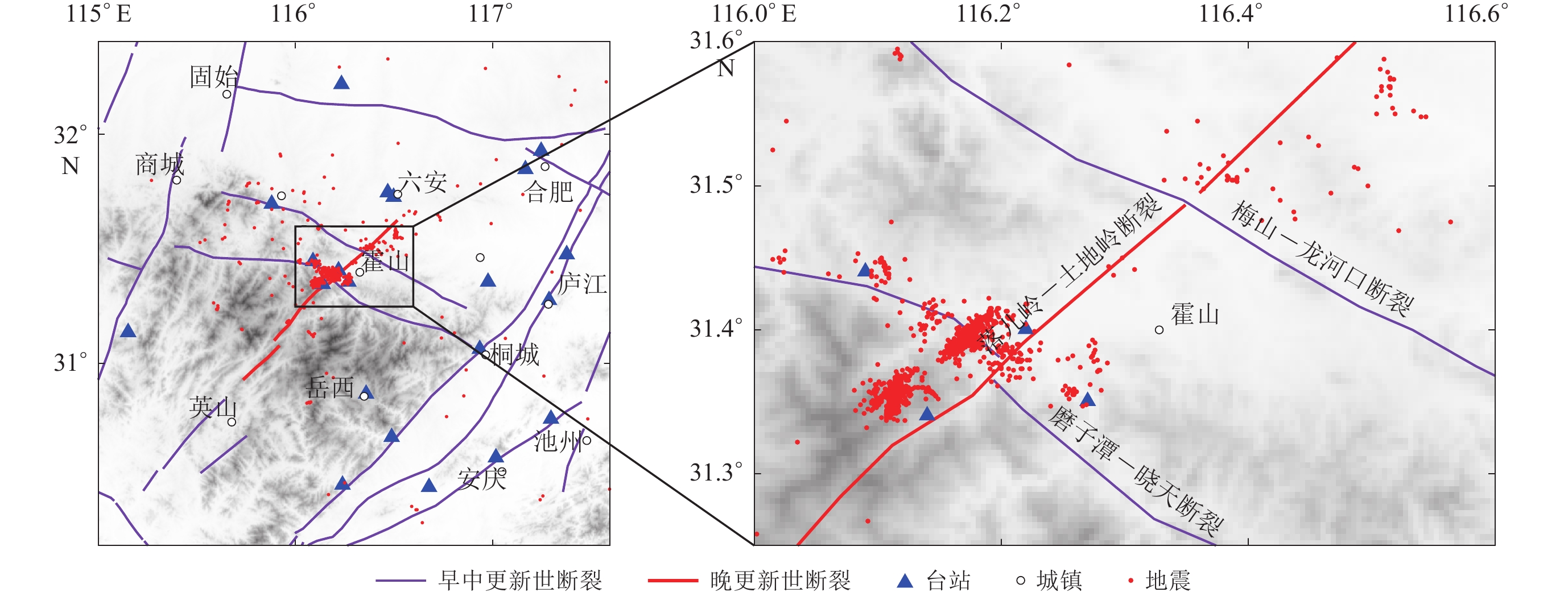
 下载:
下载:
